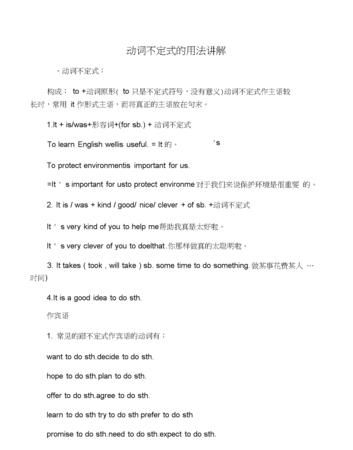本文目录
英语中的动词不定式指什么
动词不定式是由“不定式符号to+动词原形”构成的一种非谓语动词结构。有些动词不定式不带to,动词不定式可以作句子的主语、表语、宾语、定语、补语、状语或单独使用。不定式保留动词的某些特性,可以有自己的宾语、状语等。动词不定式和它后面的宾语、状语等一起构成短语,叫作不定式短语。现对九年级动词不定式的用法作一次简要梳理。
一、用作主语
直接把动词不定式置于句首的情况不多,多数情况用it作形式主语,把真正的主语——动词不定式置于句末,特别是不定式短语较长时。动词不定式作主语,谓语动词用第三人称单数形式。带疑问词的不定式短语作主语常置于句首,复合不定式结构作主语常置于句末。如:
1.As
young
adults,
it
is
our
duty
to
try
our
best
to
deal
with
each
challenge...
(p.8)
2.The
head
teacher
said
it
was
necessary
to
talk
with
his
mother.
(p.16)
3.How
to
make
requests
politely
is
important.(p.93)
二、用作表语
动词不定式作表语,常说明主语的内容、性质、特征。如:
1.The
best
way
to
improve
your
English
is
to
join
an
English
club.
(p.7)
2.The
first
thing
is
to
greet
the
teacher.
(p.96)
三、用作宾语
1.可以接带to的动词不定式作宾语的动词主要有:要求选择同意(ask,
choose,
agree),期望决定学习(expect,
hope,
decide,
learn),宁可假装知道(prefer,
pretend,
know),希望想要愿意(wish,
want,
would
like
/
love)。如:
1)We
decided
to
talk
to
some
students
about
why
they
go
there.
(p.88)
2)He
prefers
to
eat
white
bread
and
rice.(p.50)
3)Id
love
to
visit
Mexico.(p.53)
2.动词decide,
know,
learn,
show,
teach,
tell...,介词结构on...可用疑问词带to的不定式短语作宾语,但why后面的不定式不带to。如:
1)Could
you
please
tell
me
where
to
park
my
car?(p.92)
2)It
gives
advice
on
what
to
do
in
lots
of
different
situations.
(p.32)
3.动词feel,
find,
make,
think等后面,可以用it作形式宾语代替真正的宾语——动词不定式,句子结构是...feel
/
find
/
make
/
...
it+adj.
/
n.+to
do...。如:
I
find
it
difficult
to
remember
everything.
(p.98)
4.既可接动词不定式又可接ving形式作宾语,意思差别不太大的动词有begin,
start,
like,
love等。一般说来,动词不定式表一次、数次的具体动作、将来动作或动作的全过程,ving形式表习惯性的连续动作。但是这种区别并不很严格,特别是美国英语,即使是习惯性的动作也可以用动词不定式。如:
1)Then
I
started
to
watch
English-language
TV.(p.6)
2)I’m
beginning
to
understand
my
Chinese
roots,
and
who
I
am.
(p.116)
begin用了进行时态,后面只接不定式作宾语,表示事情刚开始,还要继续下去。
3)I
like
to
eat
vegetables.
(p.118)
感知动词like,
love,
know等一般不用进行时态。

动词不定式在什么时候用?
1.以疑问词引导的动词不定式作宾语——注意:不属于宾语从句!
2.少数情况用在将来时be to do sth.意思是:将要做某事,但是各地中考几乎都不考
3.动词不定式作主语、宾语、状语,用作主语时有两种句型:It is +adj.+ to do sth.(it作形式主语)
To do sth. is adj.
有什么错误请原谅

在什么情况下用动词不定式呢
在英语中,用到动词不定式的情况有很多:
在语法中,动词不定式是指动词的一种不带词形变化从而不指示人称、数量、时态的形式。它被叫做不定式,是因为动词不被限定,或者说不被词形变化所局限。不定式属于非谓语动词。
如果动词不定式的逻辑主语是这个不定式所表示的动作的承受者,不定式一般要用被动语态形式。如:
It's a great honour to be invited to Mary's birthday party.不定式作主语是被动语态to be invited是被邀请
It was impossible for lost time to be made up.不定式作主语
I wish to be sent to work in the country.不定式作宾语
Can you tell me which is the car to be repaired?不定式作定语
He went to the hospital to be examined.不定式作状语
在There be结构中,修饰主语的不定式可用被动,也可用主动如:There are still many things to take care of (to be taken care of).但有时两种形式表达的意思不同,如:There is nothing to do now.( We have nothing to do now.) There is nothing to be done now.(We can do nothing now.)
形式
1) 现在式:一般现在时表示的动词,有时与谓语动词表示的动作同时发生,有时发生在谓语动词的动作之后。
He seems to know this.
I hope to see you again. = I hope that I'll see you again. 我希望再见到你。
完成式:表示的动作发生在谓语动词表示的动作之前。
I'm sorry to have given you so much trouble.
He seems to have caught a cold.
进行式:表示动作正在进行,与谓语动词表示的动作同时发生。
He seems to be eating something.
完成进行式:
She is known to have been wreaking on the problem for many years.
一般在表示情绪的动词后加to do也表将来
疑问词
疑问词who,what,which,when,where,whether,how后可接不定式构成不定式短语,在句中作主语、宾语、表 语等。如:
When to leave for London has not been decided yet. 不定式在句子中做主语Mr. Smith didn't know whether to leave or stay there. 不定式在句子中做宾语
I asked Professor Xu how to learn English well. 不定式在句子中做直接宾语
The question was where to get the medicine needed. 不定式在句子中表语)
以上例句中疑问词+不定式部分,均可转换为相应的从句形式。如:When we shall leave…③…how I could learn……
经常在这种结构中使用的动词有:consider,decide,discover,explain,find out,forget,hear,know,learn,observe,understand,wonder等。
作主语
动词不定式作主语时,句子的谓语动词常用单数,其位置有以下两种:
把不定式置于句首。如:
To get there by bike will take us half an hour.
骑自行车到那儿将花费我们半个小时。
To make up for lost time is not possible.
要弥补失去的时光是不可能的。
To lean out of the window is dangerous.
身子探出窗外很危险。
To save money now seems impossible.
现在好像不可能存钱。
用it作形式主语,把真正的主语不定式置于句后,常用于下列句式中。如:
It+be+名词+to do
It's our duty to take good care of the old.
照顾老人是我们的责任。
It takes sb+some time+to do
How long did it take you to finish the work?
你花了多少时间来完成这项工作?
It+be+形容词+for sb+to do
It is difficult for us to finish writing the composition in a quarter of an hour.
我们难以在四分之一小时内完成这篇作文。
It is stupid of you to write down everything (that) the teacher says.
你把老师说的所有东西都记下来的行为是很愚蠢的。
It is an offence to drop litter in the street.在
马路上乱丢废物是违章的。
It seems(appears)+形容词+to do
It seemed impossible to save money.
在句型③中,常用表示客观情况的形容词,如:difficult,easy,hard,important,impossible,necessary 等;
在句型④中,常用careless,clever,good,foolish,honest,kind,lazy,nice,right,silly,stupid,wise等 表示赞扬或批评的词。
在不定式前的sb,可看作其逻辑主语。这一句式有时相当于Sb is+形容词+to do句式 ,如:It's kind of you to help me with my English.=You are kind to help me with my English.
It + 不定式结构可位于believe/consider/discover/expect/find/think和wonder之后
He thought it would be safer to go by train.
他认为乘火车比较安全。
He will find it is hard to make friends.
他会感觉到交朋友困难。
不定式的完成式也可作句子的主语
eg:
To have made the same mistake twice was unforgivable.
两次犯同样的错误是不可原谅的。
It is better to have loved and lost than never to have loved at all.
爱过而后失去了爱,比从未爱过要好。
不定式作为句子成分时,动词用单数形式。
当不定式作主语的句子中又有一个不定式作表语时,不能用It is… to…的句型(对)To see is to believe. 眼见为实 < 正确 >
It is to believe to see. < 错误 >
作宾语
以下动词后,只能跟不定式作宾语
afford (付得起),agree(同意),aim(力求做到),appear(显得),arrange(安排),ask(要求),attempt (试图),care(想要),choose(决定),claim(声称),condescend(屈尊),consent(准许),decide(决定),demand(要求),determine(决心),endeavor(竭力),expect(期待),fail(未履行),help(帮助),hesitate(犹豫),hope(希望),learn(学会),manage(设法),neglect(疏忽),offer(主动提出),plan(计划),prepare(准备),pretend(假装),proceed(接着做),promise(答应),prove(证明),refuse(拒绝),resolve(解决),seem(觉得好像),swear(发誓),tend(往往会),threaten(预示),undertake(承诺),volunteer(自愿做),vow(发誓),want(想要),wish(希望)
eg:
The driver failed to see the other car in time.
司机没能及时看见另一辆车。
I happen to know the answer to your question.
我碰巧知道你那道问题的答案。
动词+疑问词+ 不定式
decide,know,consider forget,learn,remember,show,understand,see,wonder,hear,find out,explain,tell
eg:
Please show us how to do that. 请演示给我们如何去做。
There are so many kinds of tape recorders on sale that I can't make up my mind which to bu.有这么多的录音机,我都拿不定主意买哪一种。
注意:疑问词带不定式在句中作成分时,谓语动词用单数。
The question is how to put it into practice.
问题是怎样把它付诸实施。
3)当复合宾语中的宾语是不定式时,先用形式宾语it代替不定式,把不定式置于补语之后,即:主语+动词+it+补语+to do句式。如:
We think it quite important for us to learn a foreign language well.
He feels it his duty to help the poor.
I find it difficult to learn English well.
作补语
动词+宾语+不定式(to do)
advise allow believe cause challenge compel declare encourage forbid force find hire induce instruct invite like order permit persuade remind request require select send suppose tell train urge
eg:
Father will not allow us to play on the street.
父亲不让我们在街上玩耍。
We believe him to be guilty.
我们相信他是有罪的。
to + be 的不定式结构,作补语的动词。
Acknowledge, believe, consider, think, declare(声称), discover, fancy(设想), feel, find, guess, judge, imagine, know, prove, see(理解), show, suppose, take(以为), understand
eg:
We consider Tom to be one of the best students in our class.
我们认为汤姆是班上最好的学生之一。
to be +形容词
Seem, appear, be said, be supposed, be believed, be thought, be known, be reported, hope, wish, desire, want, plan, expect, mean…
eg:
The book is believed to be uninteresting.
人们认为这本书没什么意思。
there be+不定式
believe,expect,intend,like,love,mean,prefer,want,wish,undrstand
eg:
We didn't expect there to be so many people there.我们没料到会有那么多人在哪里。
有些动词需用as 短语做补语,如regard,think believe,take,consider.
eg:
We regard Tom as our best teacher. 我们认为汤姆是我们最好的老师。
Mary took him as her father . 玛丽把他当作自己的父亲。
秃头不定式作补语
秃头不定式, 即不带“to”的不定式,其语法功能一般在句子中作宾语的补语(宾语补足语)。用秃头不定式作宾语补足语的常用动词如下:
口诀:“五看、三使役“,“两听、一感”要记住,若是“宾补”变“主补”,主补“to”字不能无。动词let属例外,其宾补/主补“to”均无。说明:
五看-----see/watch/notice/observe/look at;三使役-----have/make/let;两听-----hear/listen to;一感-----feel。
eg:
I often see him go to school on foot.(秃头不定式作宾语补足语) He is often seen to go to school on foot.(不定式作主语补足语,要带“to”) Let him try again.---- He is let try again.(let的主补与宾补均用秃头不定式)
Find 特殊用法
Find 后可用分词做宾补,或先加形式宾语,再加形容词,最后加带to 的动词不定式。find后也可带一个从句。此类动词还有get,have。
eg:
I found him lying on the ground.
I found it important to learn.
I found that to learn English is important.

什么时候用动词不定式
动词总介
表示动作中状态的词叫做动词。
1) 根据其在句中的功能,动词可分为四类,
分别是:实义动词(Notional Verb)、系动词(Link Verb)、助动词(Auxiliary Verb)、情态动词(Modal Verb)。 还可以分成及物动词和不及物动词
说明:有些情况下,有些动词是兼类词,例如: We are having a meeting. 我们正在开会。 (having是实义动词。) He has gone to New York. 他已去纽约。 (has是助动词。)
2) 动词根据其后是否带有宾语分为两类,
分别是:及物动词(Transitive Verb)、不及物动词(Intransitive Verb),缩写形式分别为vt. 和vi.。
说明:同一动词有时可用作及物动词,有时可用作不及物动词。例如: She can dance and sing. 她能唱歌又能跳舞。(sing在此用作不及物动词。) She can sing many English songs. 她能唱好多首英文歌曲。(sing用作及物动词。)
3) 根据是否受主语的人称和数的限制
分别是:限定动词(Finite Verb)、非限定动词(Non-finite Verb)例如:
She sings very well. 她唱得很好。(sing受主语she的限制,故用第三人称单数形式sings。) She wants to learn English well. 她想学好英语。(to learn不受主语she的限制,没有词形变化,是非限定动词。 说明:英语中共有三种非限定动词,分别是:动词不定式(Infinitive)、动名词(Gerund)、分词(Participle)。
4) 根据动词的组成形式,可分为三类,
分别是:单字词(One-Word Verb)、短语动词(Phrasal Verb)、动词短语(Verbal Phrase)例如: The English language contains many phrasal verbs and verbal phrases. 英语里有许多短语动词和动词短语。(contains是单字动词。) Students should learn to look up new words in dictionaries. 学生们学会查字典。(look up是短语动词。) The young ought to take care of the old. 年轻人应照料老人。(take care of是动词短语。)
5)动词有五种形态,
分别是:原形(Original Form)、第三人称单数形式(Singular Form in Third Personal)、过去式(Past Form)、过去分词(Past Participle)、现在分词(Present Participle)。

以上就是关于什么时候使用动词不定式 ,英语中的动词不定式指什么的全部内容,以及什么时候使用动词不定式 的相关内容,希望能够帮到您。
